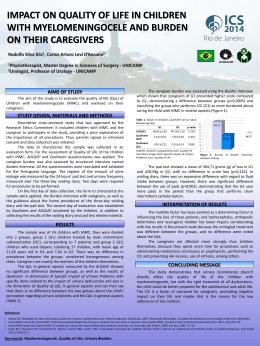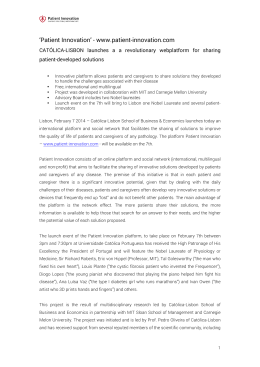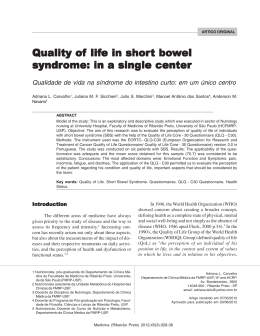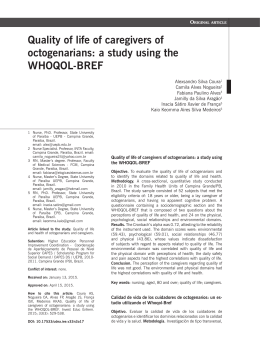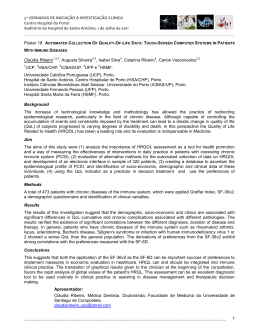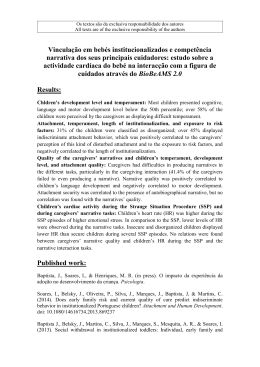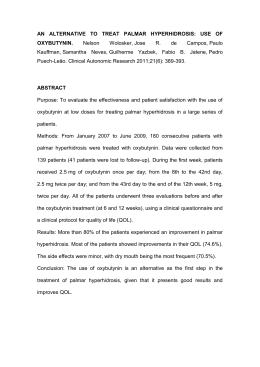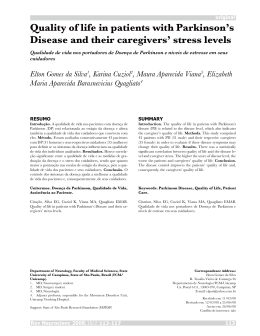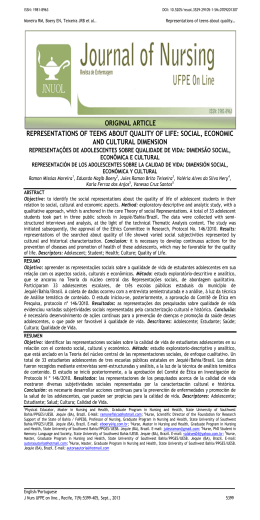Universidade Federal de São Paulo - UNIFESP PEP – First-Episode Psychosis Research and Assistence Program First-Episode Psychosis and the caregivers’ Quality of Life: the Negative symptoms patients caregivers’ show worse QoL Rita Jorge1; Ana Chaves1 Introduction Results The onset of a FEP may directly affect patient's family members disrupting their lives. However, there are few studies on the caregivers’ Quality of Life (QoL) in Brazil. tabela Negative PANSS sub-scale association with decreased caregivers’ Qol: Poor rapport x Physical functioning (r = -0.377, p: 0.001) Difficulty in abstract thinking x General health (r = -0.355, p: 0.001) Lack of spontaneity and flow of conversation x Physical functioning Stereotyped thinking x General health (r = -0.448, p: 0.001). The purpose of this study is to asses the FEP patients caregivers’ Qol and correlates this data with patients’ symptoms. Positive PANNS sub-scales association with decreased caregivers’ QoL: Conceptual disorganization x Pain (r = -0.378, p: 0.001) Conceptual disorganization x General Health (r = -0.378, p: 0.001). Methods Fifty caregivers of 50 patients admitted to a FEP Program in São Paulo, Brazil, underwent to an ad hoc questionnaire and the Short Form-36. Discussion The SF-36 is a generic and multidimensional instrument to evaluate of Quality of Life, which consists of 36 items comprised in 08 domains (Functional Capacity, Physical Aspects, Pain, General Health Status, Vitality, Social Aspects, Emotional Aspects, and Mental Health), each of them with a score of 0 to 100, with 0 indicating the worst state of health and 100 the best. Family members are the main caregivers of FEP patients in Brazil and they experiencing distress and difficulties that impair their well-being and QoL, since the beginning of the treatment. Their Qol are compromised mainly in General Health, Social aspects, Mental health and Physical functioning. Patients were evaluated at admission by Structured Clinical Interview for DSM Disorders (SCID-I) and Positive and Negative Syndrome Scale (PANSS). The caregivers of patients with higher Negative PANSS scale had worse QoL. A special care for these caregivers may could offer a model to develop adequate psychoeducational strategies in family interventions. Conclusions Caregivers of patients with negative symptoms present a negative impact on their QoL. Results The caregivers were 40 women (80%), 33 were mothers of the patients (66%) at the average age of 46.1 years (DP: 12,88) and 43 live in the same home with the patient (86%). These caregivers should be followed up carefully to evaluate if the negative impact on their QoL remains after their involvement in the treatment. The patients were 29 men (58%) at the average age of 24.34 years (DP = 7.21) and with diagnoses based on DSM-IV: 25 with affective (50%) and 25 with non-affective psychosis (50%). The mean positive PANSS score was 18.38 (SD: 5.39) and Negative: 21.54 (SD: 8.13). Caregivers’ QoL was compromised. The domains more affected were: Emotional role (49,33 points, DP = 45,29), Vitality (62,50 points, DP = 24,02) and Pain (65,18 points, DP = 28,19). (GRAFICO) FAZER TABELA DE CORRELAÇAO Total Positive PANSS x Pain (r = -0.288, p: 0.001); Total Positive PANSS x General health (r = -0.291, p: 0.001) Total Negative PANSS x General health (r = -0.314, p: 0.001) Total Negative PANSS x Emotional aspects (r = -0.319, p: 0.001) Total Negative PANSS x Mental health (r = -0.343, p: 0.001) Total Negative PANSS x Physical functioning (r = -0.392, p: 0.005) References 1) Addington J.; McCleery A.; Addington D., 2005, Three-year outcome of family work in an early psychosis program, Schizophrenia Research 79 (2005) 107–116 2) Cabral R. R. F.; Chaves A. C., Conhecimento sobre a doença e expectativas do tratamento em familiares de pacientes no primeiro episódio psicótico: um estudo transversal. Rev. psiquiatr. Rio Gd. Sul [periódico na Internet]. 2005 Abr [citado 2007 Ago 28] ; 27(1): 32-38. 3) Ciconelli R.M., Ferraz M.B., Santos W., Tradução para a língua portuguesa e validação do questionário genérico de avaliação de qualidade de vida SF-36 (Brasil SF-36). Rev Bras Reumatol 1999; 39:143 -50 4) Galego J. C. et al; Chronic daily headache: stress and impact on the quality of life. Arq. Neuro-Psiquiatr. [serial on the Internet]. 2007 Dec [cited 2009 Oct 19] ; 65(4b): 1126-1129. 5) Ministério de saúde;Legislação em saúde mental 1990-2004;editora MS;2004;07-27;100-105;302-307 6) Monteiro V. B. M.; Santos J. Q.; Martin D., Patients' relatives delayed help seeking after a first psychotic episode. Rev. Bras. Psiquiatr. [serial on the Internet]. 2006 June [cited 2007 Aug 28] ; 28(2): 104-110. 7) Pimenta F. A. P. et al. Avaliação da qualidade de vida de aposentados com a utilização do questionário SF-36. Rev. Assoc. Med. Bras. [serial on the Internet]. 2008 Feb [cited 2009 Oct 19] ; 54(1): 55-60. 8) LIMA, M. G. et al . Health related quality of life among the elderly: a population-based study using SF-36 survey. Cad. Saúde Pública, Rio de Janeiro, v. 25, n. 10, Oct. 2009 Authors 1 – Rita Jorge: Master’s Student of Mental Health of pela UNIFESP/ EPM. Psyquiatrist of First-Episode Psychosis Research and Assistence Program - UNIFESP / EPM. 2 – Ana Chaves: Professora afiliada do Departamento de Psiquiatria da Universidade Federal de São Paulo Unifesp / EPM. Pós-doutorada pela Universidade de Toronto. Doutora em Psiquiatria e Psicologia Médica pela Unifesp / EPM. Mailling to: [email protected] This work was supported by FAPESP. Process number: 2008/10635-5.
Download
